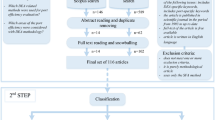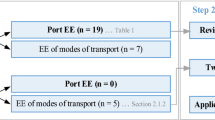Abstract
Data envelopment analysis (DEA) is a non-parametric analytical methodology widely used in efficiency measurement of decision making units (DMUs). Conventionally, after identifying the efficient frontier, each DMU is compared to this frontier and classified as efficient or inefficient. This paper first introduces the strongly efficient frontier (SEF) and strongly inefficient frontier (SIF), and then proposes several models to calculate various distances between DMUs and both frontiers. Specifically, the distances considered in this paper include: (1) both the distance to SEF and the distance to SIF, where the former reveals a unit’s potential opportunity to become a best performer while the latter reveals its potential risk to become a worst performer, and (2) both the closest distance and the farthest distance to frontiers, which may provide different valuable benchmarking information for units. Subsequently, based on these distances, eight efficiency indices are suggested to rank DMUs. Due to different distances adopted in these indices, the efficiency of units can be evaluated from diverse perspectives with different indices employed. In addition, all units can be fully ranked by these indices. The efficiency of 24 major Asian container ports is analyzed with our study, where the potential opportunities and potential crises of these ports are revealed and some new insights about their efficiency are provided.
Similar content being viewed by others
References
Adler N, Friedman L, Sinuany-Stern Z (2002) Review of ranking methods in data envelopment analysis context. Eur J Oper Res 140: 249–265
Andersen P, Petersen NC (1993) A procedure for ranking efficient units in data envelopment analysis. Manag Sci 39(10): 1261–1264
Andersen TR, Hollingsworth KB, Inman LB (2002) The fixed weighting nature of a cross-evaluation model. J Product Anal 18(1): 249–255
Aparacio J, Ruiz JL, Sirvent I (2007) Closest targets and minimum distance to the Pareto-efficient frontier in DEA. J Product Anal 28: 209–218
Baeka C, Lee JD (2009) The relevance of DEA benchmarking information and the least-distance measure. Math Comput Model 49: 265–275
Banker RD, Charnes A, Cooper WW (1984) Some models for estimating technical and scale efficiencies in data envelopment analysis. Manag Sci 30: 1078–1092
Barros CP (2003) The measurement of efficiency of Portuguese sea port authorities with DEA. Int J Transp Econ 30(3): 335–354
Barros CP (2006) A benchmark analysis of Italian seaports using data envelopment analysis. Marit Econ Logist 8(4): 347–365
Brockett PL, Cooper WW, Wang YY, Shin HC (1998) Congestion and inefficiency in Chinese production before and after the 1978 economic reforms. Socio-Econ Plan Sci 32: 1–20
Charnes A, Cooper WW, Rhodes E (1978) Measuring the efficiency of decision making units. Eur J Oper Res 2: 429–444
Charnes A, Cooper WW, Golany B, Seiford L, Stutz J (1985) Foundations of data envelopment analysis for Pareto-Koopmans efficient empirical production functions. J Econ 30: 91–107
Cooper WW, Park KS, Pastor JT (1999) RAM: a range adjusted measure of inefficiency for use with additive models, and relations to other models and measures in DEA. J Product Anal 11: 5–24
Cooper WW, Seiford LM, Zhu J (2004) Handbook on data envelopment analysis. Springer, Boston
Cooper WW, Seiford LM, Tone K (2006) Introduction to data envelopment analysis and its uses: with DEA-solver software and references. Springer, New York
Cullinane KPB, Song DW, Ji P, Wang T (2004) An application of DEA Windows analysis to container port production efficiency. Rev Netw Econ 3(2): 186–208
Doyle J, Green R (1994) Efficiency and cross efficiency in DEA: derivations, meanings and the uses. J Oper Res Soc 45(5): 567–578
Frei FX, Harker PT (1999) Projections onto efficient frontier: theoretical and computational extension to DEA. J Product Anal 11: 275–300
Jahanshahloo GR, Afzalinejad M (2006) A ranking method based on a full-inefficient frontier. Appl Math Model 30: 248–260
Liu CC (2008) Evaluating the operational efficiency of major ports in the Asia-Pacific region using data envelopment analysis. Appl Econ 40: 1737–1743
Lovell CAK, Pastor JT (1995) Units invariant and translation invariant DEA models. Oper Res Lett 18: 147–151
Paradi JC, Asmild M, Simak P (2004) Using DEA and worst practice DEA in credit risk evaluation. J Product Anal 21: 153–165
Pastor JT (1994) New additive models for handling zero and negative data. Working Paper, Alicante, Spain. Universidad de Alicante, Departamento de Estadstica e Investigacin Operativa
Portela MCAS, Borges PC, Thanassoulis E (2003) Finding closest targets in non-oriented DEA models: the case of convex and non-convex technology. J Product Anal 19: 251–269
Robinson R (1998) Asian Hub/Feeder nets: the dynamics of restructuring. Marit Policy Manag 25(1): 21–40
Roll Y, Hayuth Y (1993) Port performance comparison applying data envelopment analysis. Marit Policy Manag 20(2): 153–161
Sexton TR, Silkman RH, Hogan AJ (1986) Data envelopment analysis: critique and extensions. In: Silkman RH (eds) Measuring efficiency: an assessment of data envelopment analysis. Jossey-Bass, San Francisco, pp 73–105
Sharma MJ, Yu SJ (2009) Performance based stratification and clustering for benchmarking of container terminals. Expert Syst Appl 36(3): 5016–5022
Tongzon J (2001) Efficiency measurement of selected Australian and other international ports using data envelopment analysis. Transp Res A 35(2): 113–128
Turner H, Windle R, Dresner M (2004) North American containerport productivity: 1984–1997. Transp Res E 40(4): 339–356
Zhu J (1996) Robustness of the efficient DMUs in data envelopment analysis. Eur J Oper Res 90: 451–460
Author information
Authors and Affiliations
Corresponding author
Rights and permissions
About this article
Cite this article
Jiang, J.L., Chew, E.P., Lee, L.H. et al. DEA based on strongly efficient and inefficient frontiers and its application on port efficiency measurement. OR Spectrum 34, 943–969 (2012). https://doi.org/10.1007/s00291-011-0263-2
Published:
Issue Date:
DOI: https://doi.org/10.1007/s00291-011-0263-2




